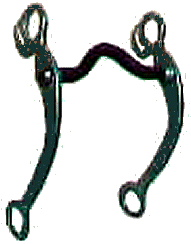Return
to Questions and Answers Index
Q&A
Questions and Answers:
QUESTION:
[Both of my horses are doing] that cow kicking thing. I must be doing something wrong.
They are both previous harness racers. Shouldn't they be used to a girth?
It's some frustrating. My daughter was learning to ride
and wanted to start saddling by herself, but I can't let her do it with the way these
critters are behaving. Maybe they are just barn sour. With my bad back, I wasn't able to
do anything with them over the winter. I am slowly getting back into it and maybe with
steady work, this will change.
My question for you is about a funny little habit my stud has. When he is saddled up and
ready to go, he doesn't mind the bit at all. When we ride, he does great while sauntering
along. However, it's when I give him a turn command that he does this twisting thing with
his head. Mostly it's when I ask him for a left turn. He kind of lays his head to the left,
his nose pointing right, and he chomps the bit. (Last fall when he was ridden he didn't do
this). I rode him for about 40 minutes and he was coming out of it by the end of the ride.
Do you suppose it has something to do with the fact that he was a harness horse? I was
wondering if it is because he was always feeling the tug on the right side of his mouth
and maybe his left side is tender.
I am having the vet check his teeth. They were done
last fall but I want to rule out mouth sores.
I have no idea what kind of bridle I am using.
I can tell you it does have the bump in the middle and the long sides to where the reins
hook.... I am embarrassed that I don't know what it's called. My other horse used the same
bridle and she has no problems with it.
Jeepers... I sure am long-winded... *s* Ponder a while and let me know what you think....
Thanks a lot.
- B. M.
ANSWER:
A harness horse does have a surcingle, but it's a lot looser than a saddle girth. When horses
aren't worked much over the winter, they'll sometimes express a little displeasure about having to
go back to work. Usually the behavior will go away with a little remedial training. Also,
the girth area may be a little tender at first. Along with good grooming and careful cinching, you
may want to keep your riding sessions shorter until the girth area has a chance to toughen up. And
remember to be consistent and always follow my safety rules regarding kicks.
Having your vet check the horse's mouth is a good idea, but I doubt it's the source of your horse's
behavior. From your description, it sounds like you're using a curb bit. As a harness
racer, he was probably worked with a snaffle bit. If you're not careful, a curb bit can
be pretty severe. Couple it with the curb chain (the little strap under the jaw) and you've got
enough power to break your horse's jaw if you're not careful. If you learn to ride with "gentle
hands," your horse will probably learn to live with the curb bit. On the other hand, if you
work the bit too much you'll soon find that your horse is thinking more about the discomfort of the bit
than he is about what you're trying to tell him. If he continues to have a problem with the bit, try a snaffle for a while.
At the risk of sounding like a broken record,
work on using your legs and balance to guide your animal, rather than the reins and bit. Not only will
your horse respond better, the extra strength you'll build in your lower body may even help to reduce
some of your back problems.

That's a snaffle bit above and a curb bit at the right. The key feature
that distinguishes a curb bit is the ring or slot where a curb chain attaches
to the bit. The combination of the curb chain and the leverage provided
by the reins pulling on the shafts can result in enough pressure to break
a horse's jaw, so be careful. A snaffle, on the other hand provides direct
contact between the reins and the horse's mouth, giving straight communication
between the rider's hands and the horse's head.
|
 |
(Check the next question and answer page for more about selecting
a bit.)
Happy Riding!
Previous Question
| Next Question
 Return to Questions and Answers Index
Return to Questions and Answers Index
 Return to the "Learning More About Horses..." page
Return to the "Learning More About Horses..." page
COPYRIGHT © 2000 BOB LEMEN, GRAND RAPIDS,
MINNESOTA. ALL RIGHTS RESERVED.
The contents of this document are not for reproduction.

